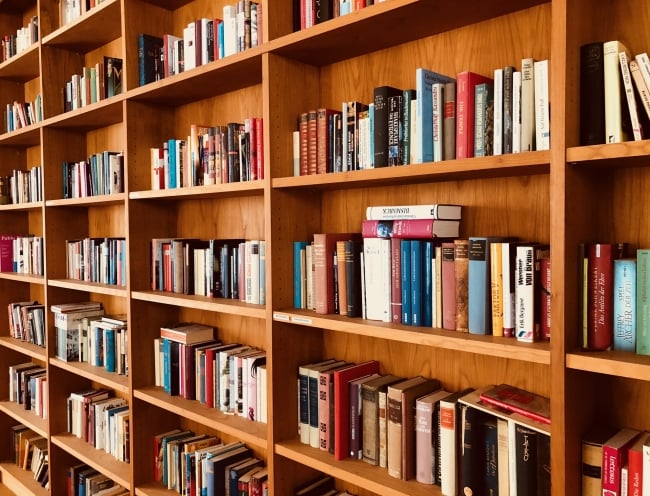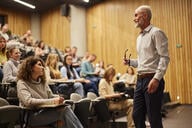You have /5 articles left.
Sign up for a free account or log in.

Advice pours in when retirement looms on your academic horizon. Human resources sends off-boarding recommendations. Brokers peddling annuities invite you to dinner. Equally altruistic insurance company reps offer complex Medicare proposals.
Yet no one ever addresses the elephant in the room for some aging professors: What to do with all the books?
The sudden passing of a recently retired colleague prompted me to search Amazon for the right self-help guide, only to realize that, within that ever-growing genre, Our Bookshelves, Ourselves is yet to be written.
Dan had had the time to ask me to sort through his professional collection of Holocaust studies texts with him, yet his decline was so sudden, so swift, that we never had the chance. Dealing with his books, though, was something I could do for his stunned spouse, and many will go to the university’s library. But in facing the task of sorting through Dan’s volumes, I began to consider the fate of my own personal library. His field was public administration, and for faculty members in that discipline, his collection may seem large. The one in my office is easily three to four times its size. And it represents only a part of the enormous library/book warehouse shared at home with my wife.
Set in a newer building, the university perch Dan occupied fell under campus design protocols limiting how much stuff one can hoard, with only one wall of four shelves. For years at Grand Valley State University, acquiring an extra filing cabinet demanded the institutional equivalent of a papal bull. Administrators knew that a crammed file drawer, like the space beneath an adolescent’s mattress, could quickly become a place of shame—a place where one could secret away that unsorted folder of student papers from 1998, those ancient CVs, those hundreds of pages of fruitless fellowship applications. I sympathize with their position and should probably kneel each day toward Silicon Valley in gratitude for being relieved of so much unnecessary paper.
But row upon row of books in a professor’s office, especially in certain disciplines, is a rather different matter—less of storage than of intellectual identity. On display and immediately at hand, they are essential tools for one’s teaching and scholarship, yes, but they also can reveal the arc of a multidecade academic career.
Two years ago, I moved into a new office, and right before me sits the story of my evolving interests: the many, many volumes on 20th-century American poetry have yielded to a far larger and multidisciplinary collection of Holocaust studies texts. There’s a fascinating collection of social history books from my team-teaching years with a historian. Volumes by Jewish American writers fill a stand-alone bookcase near the door. And buried in a corner rest a few sorry remnants from my early years teaching freshman writing.
My longtime office in the now-remodeled building, mine for two decades, is now part of a study lounge. Before the transformation, our space was some of the oldest on campus, a historical site predating the university’s rapid growth during my tenure. There I could fill three walls with floor-to-ceiling bookshelves. Reaching the highest ones required perching atop a desk or table. Tall steel standards, screwed into the concrete block walls, could bear an enormous amount of weight and were easy to adjust. So much so, that I recall once contemplating the idea that if I could reduce the distance between each just an inch or two—and if I could pilfer the extra boards—I could squeeze another level in!
Still among my office books is a well-worn copy of John Milton’s Paradise Lost, which should have prepared me for being cast out from my old book-lined garden. Though relocated in October 2020 to a new corner office with ceiling-high windows that overlook a wooded ravine, I still felt like Adam and Eve in that epic poem’s last lines, facing an uncertain and diminished world, especially when opposite the spectacular windows I saw the now standard shelves along a single wall.
Back then, I began a half-hearted triage, with multiple copies of teaching texts the first to go. (Did I really own seven different copies of The Scarlet Letter?) Older, seldom-used editions of various anthologies were next. But having to do this work during that pandemic semester of fall 2020 proved too much to process. The building that day—and every day that term—was hauntingly empty, reminding me of an old Twilight Zone episode in which Burgess Meredith played a “bookworm” who survives a nuclear attack. With no one else left in New York, he can gather and read all the books he has ever desired. Reaching for the first volume in his book-filled paradise, he stumbles and his glasses shatter. I stopped midsort, leaving several large boxes stashed in a vacant office. Where they still sit.
I can sympathize with those in the facilities department who wonder why faculty members use their offices as book warehouses. Some colleagues in STEM departments ask me, “Isn’t everything available online?” In the age of Google Books and the Internet Archive, the challenge is not that far off base, if you view books as utilitarian, as tools that digitization can make more compact, more portable, more efficient. Our provost told me she has converted most of her library to digital texts, saying the books she read to her children were the toughest to surrender, but that she felt liberated from the weight of so many physical volumes.
I suppose the professor surrounded by walls of books, like a pharaoh in his treasure-filled tomb, will soon be buried by the sands of time. With so many other aspects of academic life under threat, having enough space to hold 2,000 volumes seems the least of worries for today’s professoriate.
Yet how many humanities majors, I wonder, were drawn to their fields by being in such a book-lined office? As if their growing passion for literature, or history or philosophy was confirmed by being in the presence of those objects of desire. For me, a first-generation student, entering a professor’s book-lined office at New York University was like passing through C. S. Lewis’s wardrobe into the magic of Narnia.
Students still comment on my single wall of books—many now double shelved—and some of my most memorable moments as a teacher have been occasioned by conversation that prompted a reach for that essential volume, the one with the potential to open a new world entire. Sliding around the desk to peer into an LCD monitor just does not feel the same. In that format all texts are equal, which too often misses what makes a great book great. To handle a facsimile edition of Whitman’s 1855 Leaves of Grass, for example—its green cover with the title stamped in gold, its large-format pages, its engraved frontispiece of a rakish Walt Whitman gazing at the reader—is to better understand how Walter Whitman became the poet who would later declare “Camerado, this is no book, / Who touches this touches a man.”
More Than Just the Reading
After doing an initial sort of Dan’s on-campus books, a month or so after his passing, I visited his home, where he had told me the best ones were to be found. I filled six grocery sacks with such classics as Raul Hilberg’s three-volume The Destruction of the European Jews. Before beginning the process of creating a list for the library, I thought to ask a colleague who teaches courses on the Holocaust and Nazism whether he wanted to select some books from Dan’s collection.
Jason was getting ready for a research trip to Berlin and was too busy to look through them, though in our email exchange he also confessed that his shelf space was at a premium. Besides his many volumes of academic scholarship, he also collects antique books from the 1914–1918 period and had just recently received several boxes of classic research texts from his graduate school mentor. In response, I sent him a marvelous video in which the late writer and bibliophile Umberto Eco is followed by a camera as he walks through the labyrinth that housed his 35,000 volumes, wending his way through shelf-filled rooms until he reaches a particular spot to grab a solitary book.
Then I noticed that Jason had a new quotation above his email signature, from the great children’s author Maurice Sendak: “There’s so much more to a book than just the reading.”
As I approach the sunset of my teaching years, when the overstuffed shelves will at last be emptied for good, I shall resist the nostalgic urge to say to student visitors, “You should have seen my other office.” Nothing says old and out of touch like an excessive longing for the past. But before the day comes when the shelves are empty and I finally close the door behind me, I will be ready for the moment when one of Dan’s books—I had to grab at least a few, didn’t I?—is the right one to hand to a student. I’ll open the flyleaf, point to the signature and say, “Let me tell you something about this book’s original owner.”




